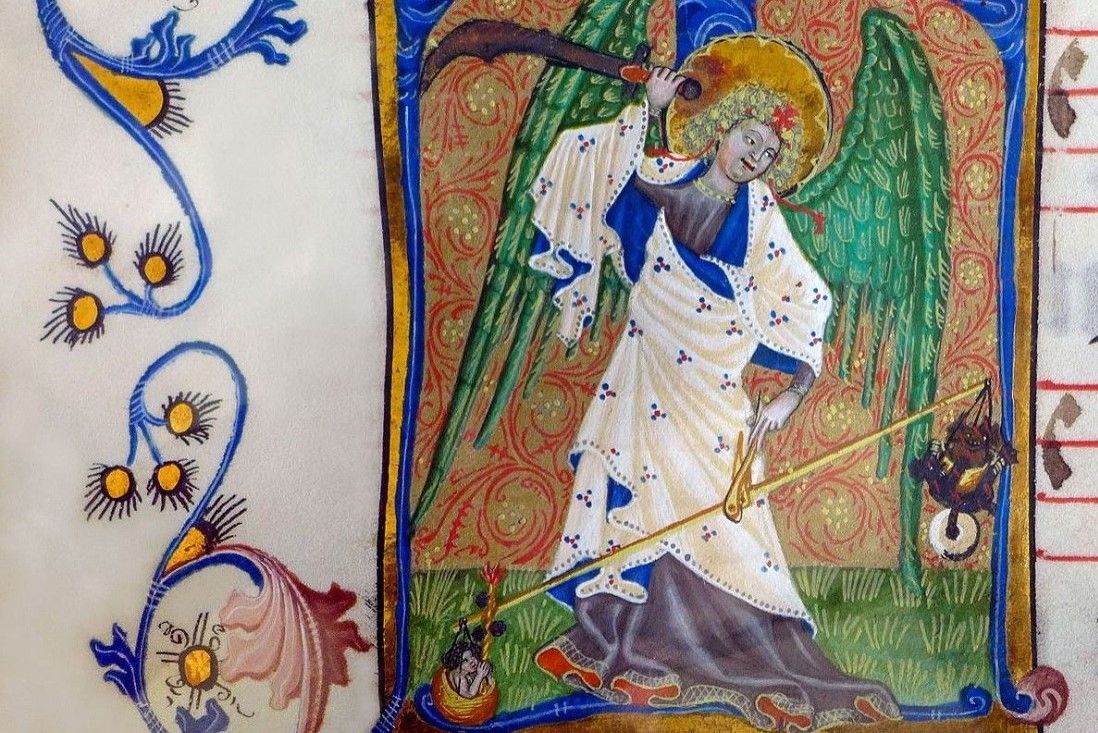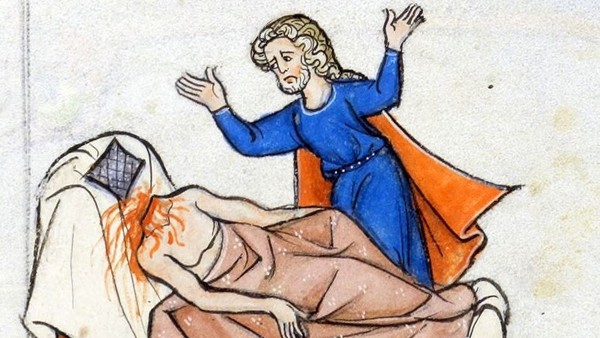If much of our cultural discourse is to be believed then moralism is an unalloyed evil. We are regressing, stepping back into the past of Poe’s “The Pit and the Pendulum,” into a time in which objective standards trumped particularity and individuality. Standing athwart history yelling “Stop!” seems to mark the only way forward against the new "Dark Ages."
Yet, prima facie, Catholics cannot really call “moralism” evil. Christians do, after all, like morals. Zealousness is, by no means, in and of itself, something to be repudiated. There is righteous anger and all-consuming wrath—one moral and the other immoral. Beyond this idea, however, what many call “moralism” may be best seen in light of the medieval Catholic literary tradition.
Moralizing is a way of seeing and interpreting others and the world that stands in contrast to the more modern way of doing things. In this sense, to moralize is not necessarily a return to the burning of heretics; rather, it hearkens to a quality embedded deeply in the Catholic literary imagination, a tendency obscured by the historical conditions under which we live, and one which may be worth more sympathy than most Catholics might initially suspect.
Literature tells us about how we think, or at least, how we want to think. I do not say that just because I myself am a two-bit literary critic; it is simply true. Authors represent the world through the lenses given them. They may struggle to break out of them, complicate them in the process, even destroy them. But each text is, in some way, determined by its historical conditions; each tells us about the world and existence of its writers, the judgments he or she made, and how all that fits together.
Beowulf gives us a glance into a long-forgotten world of fealty and warfare. Jane Eyre reflects the anxieties, difficulties, and aspirations of a teetering social class, one that forms both its audience and its subject matter. Infinite Jest—perhaps the ultimate post-modern novel—relishes discourse for discourse’s sake, even as it pushes against it, much as millions of Twitter users do every day.
Modern fiction is—in a word—obsessed, obsessed with self-consciousness and its ramifications. This led to changes in the very form of mainstream literature. The novel came into being. As Gerald Morgan has written:
True reality becomes firmly identified with the individual and his consciousness of his own existence. A new literary genre (the novel) comes into being in order to express in a thoroughgoing way the new sense of the reality of individual experience, and a new word (psychology) is coined in order to identify a new awareness of the quality of human experience . . . Our modern literary predispositions . . . have been largely formed by a wholehearted acceptance of the novel and a commitment to the literary values that it embodies. We are especially well-equipped to see and to appreciate psychological subtleties.[1]
This produced, in the 18th century, a reaction from Neoclassical scholars whose sensibilities had not been molded by this interest in human psychology. This conflict is largely forgotten by us, allowing us to read our sensibilities into the past. We cannot simply erase the past, of course. C.S. Lewis, for example, saw allegory as the exteriorization of human interior life, which may be thought of as an attempt to find rich psychology in the medieval.[2] And so, we say that Chaucer is the father of modern, psychologically-complex, English fiction. Derek Pearsall has commented on “Chaucer’s interest in the workings of the individual human consciousness.”[3] In order to be the sire of “English literature,” he must be made into something modern, a proto-novelist, pushing allegory to the point of breaking.
Chaucer, in other words, must become a modern reader and writer, fascinated by human self-consciousness. Medieval literature, by and large, however, is not quite like this. It relies on a belief in fairly-unambiguous good and in evil, in which individual characters may be interpreted in terms of their actions and qualities. When, in The Canterbury Tales, we begin with a description of each pilgrim, each of these is intended to clue the reader into all that he needs to know about the person in question. Take, for example, Chaucer’s portrait of the Miller:
The MILLER was a stout fellow indeed;
He was very strong of muscle, and also of bones.
That was well proven, for wherever he came,
At wrestling he would always take the prize.
He was stoutly built, broad, a large-framed fellow;
There was no door that he would not heave off its hinges,
Or break it by running at it with his head.
His beard was red as any sow or fox,
And moreover broad, as though it were a spade.
Upon the exact top of his nose he had
A wart, and thereon stood a tuft of hairs,
Red as the bristles of a sow's ears;
His nostrils were black and wide.
He wore a sword and a buckler by his side.
His mouth was as large as a large furnace.
He was a loudmouth and a buffoon,
And that was mostly of sin and deeds of harlotry.
He well knew how to steal corn and take payment three times;
And yet he had a thumb of gold, indeed.
He wore a white coat and a blue hood.
He well knew how to blow and play a bag-pipe,
And with that he brought us out of town.
(Prologue, 545-566)[4]
We see class identifiers immediately. The Miller is a successful peasant—strong, as glimpsed by his prowess in wrestling and his thick frame. His temper is made clear by his sword, buckler, and loud mouth, from which curses and jollity proceed simultaneously; this, of course, is another marker of crassness and class background. Millers, in Chaucer’s day, were commonly said to cheat their clients by stealing some of the wheat they were paid to mill. Thus, the poet includes this idea in the portrait. He is a miller, like any other—or, at least, he is the idea medieval people had of millers, like any other. His tale is a fabliau—short, crude, and raunchy. Chaucer primes the reader to expect just such a story by stereotypical descriptions. If he has an interior life, we cannot separate it from his actions. The Miller, like all the pilgrims, is a flat surface.
This flattening also implies a moral dimension. Chaucer’s Pardoner, for example, is an ecclesiastical official. Pardoners, in general, were notorious for their hypocrisy and corruption, walking around with fake relics in tow, trying to make a quick buck. This poet’s version is no different; he is a manifest and open hypocrite defined by readily-observable qualities:
With him there rode a fine PARDONER
Of Rouncivale, his friend and his companion,
Who had come straight from the court of Rome.
Very loud he sang "Come hither, love, to me!"
This Summoner harmonized with him in a strong bass;
There was never a trumpet of half so great a sound.
This Pardoner had hair as yellow as wax,
But smooth it hung as does a clump of flax;
By small strands hung such locks as he had,
And he spread them over his shoulders;
But thin it lay, by strands one by one.
But to make an attractive appearance, he wore no hood,
For it was trussed up in his knapsack.
It seemed to him that he rode in the very latest style;
With hair unbound, save for his cap, he rode all bare-headed.
He had glaring eyes such as has a hare.
(Prologue, 669-684)[5]
Summoners were also known for their corruption and extortion; associating the Pardoner with such a person makes him immediately suspect. His long, messy hair and beady eyes mark him as somewhat physically repulsive. And yet, we hear that he knows how to sing, knows how to convince people to give him money. Similarly, he rides in what he thinks are the best fashions, implying not only his skill in extorting people but also his desire to do so, to better enrich himself. The description betrays him as morally bankrupt.
The Pardoner is often said to be among Chaucer’s most psychologically-complex characters. He is a hypocrite who openly says as much. Yet his tale is well-told; it is a homily, taking radix malorum est cupiditas[6] as its base text, attacking avarice, gambling, and a multitude of sins. Is this not complex consciousness in literary form, a refusal to flatten people into stereotypes? Here is a man full of contradictions, somehow working through them!
Even here, however, when Chaucer is pushing medieval commonplaces to their limits, there is little of Henry James or Virginia Woolf. The Pardoner’s hypocrisy is his personality. It is never suggested that he is conflicted about what he does, or that he does anything besides relish the irony that is his life. He is a skilled moralist, exhorting others to virtue in the name of his own vice. That’s it; he is not on the verge of a self-revelation. We want him to be more because we are trained to expect more, to expect a voyage into the perilous abyss of human consciousness. As Derek Pearsall comments:
The Pardoner thus creates in us a powerful response, and yet as a character he has no capacity for change or self-awareness, and no insight into himself. There is no inner consciousness, because there is no "within." He puts on a brilliant performance, but it is like that of a marionette, or a clockwork toy, which once wound up goes through its motions mechanically.[7]
Scholars have pushed back in a similar way to readings of Chrétien de Troyes, who is sometimes said to have nearly inaugurated the novel a half-millennium before it officially came into being.[8]
None of this is to say that medieval writers did not work through complex characterizations. To say Chaucer trades in stereotypes is not to deny his manifest skill. The point, rather, is that texts of the Middle Ages reflect the ways in which the medieval Christian mind was wont to see the world. When almost everyone is Christian, and there is a clear sense of good and evil, people may be interpreted in terms of the signs of vice and virtue. The internal workings of the human mind were a moot point as long as one lived in specific ways. Why bother with paralyzing human contradictions when the world is a sacred space of sins and blessings, a place in which our actions manifest who and what we are?
Can this willingness to trust exterior qualities as indicators of individual consciousness be bad? Absolutely. Simply assuming we understand others with no questioning, no self-reflection, is a recipe for disaster. On the other extreme, however, we have the problem of post-modern self-consciousness, in which the free indirect discourse of our minds risks self-imprisonment. Bogged down in our own thoughts, we find ourselves convinced that only we are actually thinking. Everyone else is an automaton. Absurd as it may sound, I have half been there myself. The disputes in analytic philosophy about qualia in other human beings only serve to reinforce the point. Many a post-modern text has the protagonist cry out for impossible recognition, a slave to the ever-recursive loop of intractable self-consciousness. The (post-)modern mind isn’t all it’s cracked up to be.
Further, a move toward this tradition of moralism has its benefits. A readiness to see evil and good in the world does not need to elicit anger or rage. A willingness to recognize these qualities may provide us with resources to better forgive others. We, as individuals, constantly do, as St. Paul would have it, what we do not mean to do; we fall into an ever-expanding number of stereotypes, many of which may be repugnant to us. If we can forgive ourselves, can we not forgive others? Can this evil not be fought with what St. Óscar Romero called “the violence of love”? An increase in zeal for justice is far from a negative. To combine this passion with a readiness to forgive and love represents an opportunity for escape from the self-effacement (and paradoxically-concomitant self-adulation) that has plagued us for centuries.
This, of course, does not mean that every campus activist knows exactly what he or she is doing. But it does mean that we need not fear “moralism” in the way some in the Church would like us to. In a time in which Catholics consider what it means to move beyond liberalism, into some further synthesis, we ought to ask ourselves how this new moralism relates to the old. To make the world and its ways legible again should be welcome; it is simultaneously a return and a pushing-forth, ressourcement at its best.
[1] Morgan, Gerald. “The Self-Revealing Tendencies of Chaucer’s Pardoner,” (The Modern Language Review, 71:2, 1976), 241-242.
[2] Lewis, C.S. The Allegory of Love (Oxford 1936), 113-115.
[3] Pearsall, Derek. “Chaucer’s Pardoner: The Death of a Salesman,” (The Chaucer Review, 17:4, 1983), 361.
[5] Ibid.
[6] “The root of evil is greed” (drawn from 1 Timothy 6:10).
[7] Pearsall 361.
[8] For one example, see Pigg, Daniel. “The Psychology of Masculine Virtue in Chrétien de Troyes’s Érec et Énide,” (Tennessee Philological Bulletin: Proceedings of the Annual Meeting of the Tennessee Philological Society, 50:1, 2013), 41-51.


